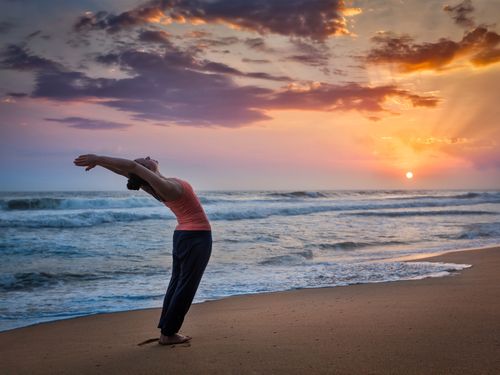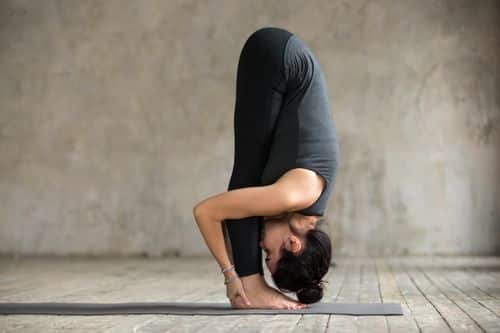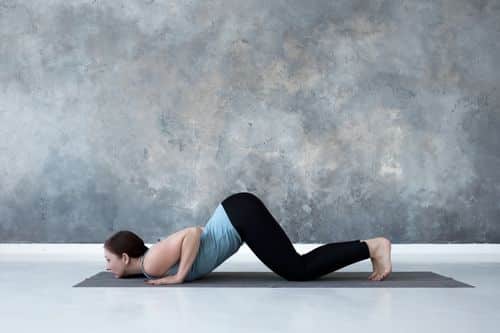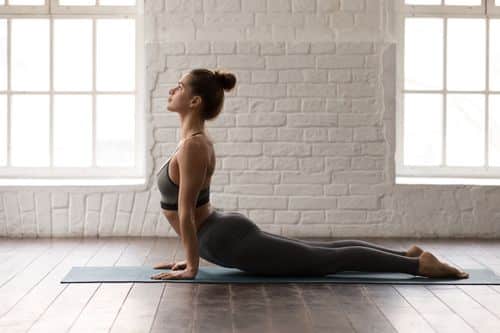Surya Namaskar: Types, Poses, Benefits, and More
Surya Namaskar Ek, Fayde Anekh. In Surya Namaskar, Surya refers to “the sun,” and Namaskar means “bowing down in respect.” This has been the most popular yogic kriyas for many decades now, as it combines 12 yoga asanas in a yogic sequence. Practicing Surya Namaskar daily helps in balancing three constituents of your body, i.e., Kapha, Pitta, and Vata, which will help you lead your life in a greater way and influence your creativity and intuitive abilities. It’s simple yet powerful poses are what make it possible for people of all age groups and all sizes to perform it, anytime, anywhere.
Table of Contents
Over the centuries, Surya Namaskar has evolved, and its poses have differed into various styles and variations. Moreover, this is one yogic kriya that never diminished but has only expanded. In reality, Surya Namaskar is integrated into various types of yoga styles. Let’s take a look at them in the section below:
- Ashtanga Surya Namaskar: In the Ashtanga Surya Namaskar series, sun salutations have two forms. -Type A and B. Type A, consists of 9 Vinyasas and type B consists of seventeen vinyasas.
- Hatha Surya Namaskar: It is performed through the 12 spinal poses, which puts deep emphasis on breathing prominently. It is one of the most commonly practiced Surya Namaskar styles and possibly the easiest one.
- Iyengar Surya Namaskar: Iyengar Surya Namaskar is similar to the Hatha practice, but here the focus is a little more on pace and energy, wherein, it is performed at a quicker pace than other Surya Namaskar types.
In this section let’s spend some time exploring the 12 classic poses of traditional Hatha Surya Namaskar.
Pose 1: Prayer pose – Pranamasana.

Execution:
- Start by standing straight at the front of your mat, bringing your feet together, and keeping arms loose alongside.
- Now, close your eyes and bring your palms to meet in the center of your chest. Relax the whole body.
Benefits:
- This pose relaxes the nervous system and helps in gaining the balance of the body.
- It also helps relieve stress and anxiety.
Pose 2: Raised arms pose – Hasta Uttanasana

Execution:
- Hasta Uttanasana is started by exhaling deeply
- Inhale deeply thereafter stretching your arms forward and bringing them up over your head.
- Look up and stretch the body slightly backward by pushing your pelvis forward.
- Breathe out. (Focus on breathing-in when you arch backward, and as you bend forward breathe-out.)
Benefits:
- Stretches and tones the muscles of the abdomen.
- Expands the whole body from heel to the tip of the fingers.
Pose 3: Hand to foot pose – Hasta Padasana.

Execution:
- Exhale and start to fold forward and down to the knees; as you come forward, keep the spine long.
- Hands down on the floor, have just your fingertips touching the floor.
- Bend the knees just enough so your chest can rest against the thighs, and your head touching your knee. Hold this position for a few seconds.
Benefits:
- It stretches the spine and makes it flexible.
- It also stretches the hamstrings and opens the legs, shoulders, and arms muscles.
Pose 4: Equestrian pose – Ashwa Sanchalanasana

Execution:
- Next, step your right leg back, putting just the knee down and comfortably tucking the toes under.
- At the same time bend the left knee leaving the foot flat on the floor.
- Press the fingertips or palms down to the floor, roll the shoulders back, and slowly lookup.
Benefits:
- Strengthens the leg muscles and spine.
- Relieves in indigestion and constipation.
Pose 5: Mountain pose – Parvatasana

Execution:
- Slowly exhale, having control bring your palms onto the floor and stepping the left foot back beside the right, lift your hips up into the air.
- Lengthening through your spine, bring the shoulders towards the ankles. Take a few breaths.
Benefits:
- It improves posture and calms the mind.
Pose 6: Ashtanga Namaskara

Execution:
- As you exhale, lower your knees down and slowly, with a controlled chest, come down while pushing your head forward on the floor.
- Keep your elbows right in against your sides; giving you more strength.
- Now, as you build more strength in this transition, you can lower the chest down and still keep your hip up in the air.
Benefits:
- It improves the flexibility of the back and spine.
- Strengthens the back muscle and relieves build up tension.
- Your eight body parts are worked in a single pose.
Pose 7: Cobra pose – Bhujangasana

Execution:
- Keep hands and feet right where they are. And inhale.
- Slide forward and raise your chest like a cobra.
- Roll the shoulders back, Keep your elbows bent, and squeeze them back towards each other.
- Slowly lookup.
Benefits:
- It improves flexibility and mood.
- It stretches the shoulders, chest, back, legs muscle, all at once.
Pose 8: Mountain pose – Parvatasana.

Execution:
- While you exhale, tuck the toes under. (same as pose 5)
- Press back to an inverted V position, lengthening through the spine, bringing the shoulders towards the ankles. Take a few breaths here. As you exhale lift the hips towards the sky and press your hands into the ground.
Benefits:
- It increases the blood flow to the spinal region.
- It relieves symptoms of menopause in women.
Pose 9: Equestrian pose – Ashwa Sanchalanasana.

Execution:
- Bring the left foot forwards between the hands, and push the pelvis forwards. Lift the torso and tilt the head back, arching the back and looking up to the sky (same as pose 4).
Benefits:
- Brings flexibility to leg muscles and tones the abdominal organs.
- Strengthens the spine.
Pose 10: Hand to foot pose – Hasta Padasana.

Execution:
- Exhale, keep the right foot in front, bringing the legs together (same as pose 3).
- Bend the knees just enough so your chest can rest against the thighs, and your head touching your knee.
Benefits:
- It helps in curing insomnia, osteoporosis, headache, anxiety, and stress.
Pose 11: Raised Arms Pose- Hasta Uttanasana

Execution:
- Inhale deeply thereafter stretching your arms forward and bringing them up over your head (same as pose 2)
- Look up and stretch the body slightly backward by pushing your pelvis forward.
- Breathe out.
Benefits:
- It cures health problems like asthma, lower back pain, and fatigue. It also aids digestion.
- Expands the chest, which results in a full intake of oxygen.
Pose 12: Standing Mountain pose – Tadasana.

Execution:
- Then, at last, exhale and come back to the prayer position (same as pose 1).
- Bring your arms down, slow and steady.
Benefits:
- Strengthens thighs, knees, and ankles and improves posture.
- Tone your hips and abdomen and help to gain control over your muscular movements.
These 12 poses when practiced make up for one cycle of Surya Namaskar. Ideally, doing 12-15 cycles a day will get you all the benefits required by the body, keeping you fit and healthy for a better tomorrow.
Other Benefits of Surya Namaskar:
- Balance of Dosha: Pita, Kapha, and Vata are three doshas that can go out of balance due to various causes. It is majorly affected by the weather, food, everyday bad activities, stress at work, and depreciated sleep. However, you can keep your dosha in line with practicing Surya Namaskar daily.
- Weight-loss Booster: Simply stretching the abdominal muscles will certainly make you lose extra calories through Surya namaskar. It also manages the hormonal secretions from thyroid glands that are responsible for weight gain.
- Improves mental health: Surya Namaskar has a great significance for children to strengthen their focus and relax their minds while reducing sleepiness, somatic stress, worry, and negative emotion at a dispositional level. It can help to revitalize the brain by engaging the spinal cord. A daily 15-minute practice can reap great results for the brain.
Summary
The physical benefits of Surya Namaskar are aplenty. This 12 posture yogic kriya lubricates all the joints of your body by synchronizing with your breath giving you better physical health and mental concentration. The regular practice of 12 rounds of Surya Namaskar not only gives you enormous benefits that let you discover who you are but also keeps your body healthy and fit from the inside out!
